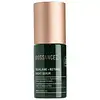What's inside
What's inside
 Key Ingredients
Key Ingredients

 Benefits
Benefits

 Concerns
Concerns

 Ingredients Side-by-side
Ingredients Side-by-side

Water
Skin ConditioningCaprylic/Capric Triglyceride
MaskingHeptyl Undecylenate
EmollientNiacinamide
SmoothingPolyacrylate-13
Glycerin
HumectantRetinol
Skin ConditioningUbiquinone
AntioxidantAvena Sativa Kernel Extract
AbrasiveHydroxymethoxyphenyl Decanone
Skin ConditioningBisabolol
MaskingCeramide NP
Skin ConditioningTremella Fuciformis Sporocarp Extract
AntioxidantBetaine
HumectantTocopheryl Acetate
AntioxidantCaprylyl Glycol
EmollientC12-15 Alkyl Benzoate
AntimicrobialCetyl Palmitate
EmollientPolysorbate 20
EmulsifyingDisodium EDTA
Ethylhexylglycerin
Skin ConditioningCaprylhydroxamic Acid
Trideceth-6 Phosphate
EmulsifyingPhenoxyethanol
PreservativePolyisobutene
Sodium Hydroxide
BufferingWater, Caprylic/Capric Triglyceride, Heptyl Undecylenate, Niacinamide, Polyacrylate-13, Glycerin, Retinol, Ubiquinone, Avena Sativa Kernel Extract, Hydroxymethoxyphenyl Decanone, Bisabolol, Ceramide NP, Tremella Fuciformis Sporocarp Extract, Betaine, Tocopheryl Acetate, Caprylyl Glycol, C12-15 Alkyl Benzoate, Cetyl Palmitate, Polysorbate 20, Disodium EDTA, Ethylhexylglycerin, Caprylhydroxamic Acid, Trideceth-6 Phosphate, Phenoxyethanol, Polyisobutene, Sodium Hydroxide
Water
Skin ConditioningSqualane
EmollientGlycerin
HumectantCaprylic/Capric Triglyceride
MaskingCetearyl Olivate
Sorbitan Olivate
EmulsifyingRetinol
Skin ConditioningRetinal
Skin ConditioningAllantoin
Skin ConditioningCrocus Sativus Stigma Extract
Pseudozyma Epicola/Evening Primrose Oil Ferment Extract
EmollientTocopherol
AntioxidantRosmarinus Officinalis Leaf Extract
AntimicrobialOryza Sativa Bran Extract
Skin ConditioningCetearyl Alcohol
EmollientHelianthus Annuus Extract
EmollientHydroxyapatite
AbrasiveDextrin
AbsorbentCarbomer
Emulsion StabilisingSodium Gluconate
Skin ConditioningPhenoxyethanol
PreservativeEthylhexylglycerin
Skin ConditioningSodium Hydroxide
BufferingWater, Squalane, Glycerin, Caprylic/Capric Triglyceride, Cetearyl Olivate, Sorbitan Olivate, Retinol, Retinal, Allantoin, Crocus Sativus Stigma Extract, Pseudozyma Epicola/Evening Primrose Oil Ferment Extract, Tocopherol, Rosmarinus Officinalis Leaf Extract, Oryza Sativa Bran Extract, Cetearyl Alcohol, Helianthus Annuus Extract, Hydroxyapatite, Dextrin, Carbomer, Sodium Gluconate, Phenoxyethanol, Ethylhexylglycerin, Sodium Hydroxide
 Reviews
Reviews

Ingredients Explained
These ingredients are found in both products.
Ingredients higher up in an ingredient list are typically present in a larger amount.
This ingredient is an emollient, solvent, and texture enhancer. It is considered a skin-softener by helping the skin prevent moisture loss.
It helps thicken a product's formula and makes it easier to spread by dissolving clumping compounds.
Caprylic Triglyceride is made by combining glycerin with coconut oil, forming a clear liquid.
While there is an assumption Caprylic Triglyceride can clog pores due to it being derived from coconut oil, there is no research supporting this.
Learn more about Caprylic/Capric TriglycerideEthylhexylglycerin (we can't pronounce this either) is commonly used as a preservative and skin softener. It is derived from glyceryl.
You might see Ethylhexylglycerin often paired with other preservatives such as phenoxyethanol. Ethylhexylglycerin has been found to increase the effectiveness of these other preservatives.
Glycerin is already naturally found in your skin. It helps moisturize and protect your skin.
A study from 2016 found glycerin to be more effective as a humectant than AHAs and hyaluronic acid.
As a humectant, it helps the skin stay hydrated by pulling moisture to your skin. The low molecular weight of glycerin allows it to pull moisture into the deeper layers of your skin.
Hydrated skin improves your skin barrier; Your skin barrier helps protect against irritants and bacteria.
Glycerin has also been found to have antimicrobial and antiviral properties. Due to these properties, glycerin is often used in wound and burn treatments.
In cosmetics, glycerin is usually derived from plants such as soybean or palm. However, it can also be sourced from animals, such as tallow or animal fat.
This ingredient is organic, colorless, odorless, and non-toxic.
Glycerin is the name for this ingredient in American English. British English uses Glycerol/Glycerine.
Learn more about GlycerinPhenoxyethanol is a preservative that has germicide, antimicrobial, and aromatic properties. Studies show that phenoxyethanol can prevent microbial growth. By itself, it has a scent that is similar to that of a rose.
It's often used in formulations along with Caprylyl Glycol to preserve the shelf life of products.
Retinol is a gold-standard ingredient for anti-aging. It is a form of Vitamin A and belongs to the class of retinoids that also includes tretinoin.
Why is retinol famous?
It has the most scientific studies backing up its skin benefits out of all the non-prescription ingredients.
Retinol is proven to:
This is why retinol is effective at removing wrinkles, fading dark spots, treating acne, and reducing the appearance of pores.
Studies show retinol is less effective when exposed to UV. Be sure to look for appropriate packaging to keep your retinol potent (similar to Vitamin C).
Using retinol or any retinoids will increase sun-sensitivity in the first few months. Though studies show retinoids increase your skin's natural SPF with continuous use, it is best to always wear sunscreen and sun-protection.
We recommend speaking with a medical professional about using this ingredient during pregnancy.
Retinol may cause irritation in some people, so be sure to patch test. Experts recommend 'ramping up' retinol use: start using this ingredient once a week and work up to using it daily.
Read about Tretinoin
Learn more about RetinolSodium Hydroxide is also known as lye or caustic soda. It is used to adjust the pH of products; many ingredients require a specific pH to be effective.
In small amounts, sodium hydroxide is considered safe to use. However, large amounts may cause chemical burns due to its high alkaline.
Your skin has a natural pH and acid mantle. This acid mantle helps prevent harmful bacteria from breaking through. The acid mantle also helps keep your skin hydrated.
"Alkaline" refers to a high pH level. A low pH level would be considered acidic.
Learn more about Sodium HydroxideWater. It's the most common cosmetic ingredient of all. You'll usually see it at the top of ingredient lists, meaning that it makes up the largest part of the product.
So why is it so popular? Water most often acts as a solvent - this means that it helps dissolve other ingredients into the formulation.
You'll also recognize water as that liquid we all need to stay alive. If you see this, drink a glass of water. Stay hydrated!
Learn more about Water